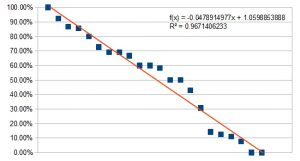In my previous article (see Executive Introduction to Machine Learning), I provided a concise, jargon-free introduction to what is machine learning. I basically described it as four steps: 1) Take data in; 2) Run it through an algorithm to make a prediction; 3) help the machine learn to make better predictions; 4) predict something based on new data. In this article, we’ll explore the various ways machines make predictions and cover some simple examples.
The Future is Digital
Becoming digital is the surest way for you to understand your customers' needs and meet their expectations. Learn how Perficient can help anticipate what's ahead for you and your customer with a digital strategy centered around empathy, alignment, and agility.
Below are the major types of predictions that we can make using machine learning.
- Regression analysis includes a variety of methods to establish relationships between variables. For example, you may know lots of information about your customer – location, age, sex, etc. – but how do know which factors will help you predict who will buy your product? Using regression analysis, our machine learning algorithm can help identify which factors are important and which are not. Once the machine learns the right relationship, we can use that algorithm to decide whether to make an offer to a new customer visiting our web site.

Linear Regression. By Guerillero (Own work) [WTFPL], via Wikimedia Commons
- Clustering is an application of machine learning where we are interested in how to segment people (or things) into groups. For example, you may want to run a marketing campaign to make offers to your best customers. Are those the customers who purchased the most? Or are those customers the ones who bought your highest priced items? By feeding data into a clustering algorithm, we try to identify the segments, or clusters, of customers so we can better target them in the future. Clustering is an example of unsupervised learning.
- Classification includes identifying to which category a person belongs. Lets say your marketing team has created several personas based on some criteria. Now you need to figure out which persona applies to a new customer visiting your website. There many different classification algorithms to choose from, depending on how the variables are associated with each other (linear vs non-linear). The classification algorithm then predicts a persona (classification) for each visitor. Classification is a supervised learning method because you have to supply the classes.
- Association Rules Learning is a form of machine learning used to make recommendations. A good example is the recommendation engine on Netflix. As you look for a movie to watch, Netflix analyzes your attributes and other ‘similar’ customers to come up with recommendations. These ‘similar’ customers can be found through Association Rules Learning.
- Reinforcement Learning is the concept of performing a task, getting feedback about whether you did well or not, then adjusting the actions taken to optimize for good feedback. In many machine learning algorithms, we have to feed in training data and then tweak the algorithm or data to get better predictions (better clusters, more correct classifications, etc.) and they usually require a lot of training data. With reinforcement learning, we may not have the training data available before hand, so the system has to learn as it goes. As an example, say you want to train a car to drive. There are so many variables and data points, its hard to know where to begin. But what if you gave the car some simple actions it could take – start engine, increase throttle, turn left, turn right, etc. The car would take an action and then get a reward if the action was successful or a punishment if not. Increasing the throttle before starting the engine would receive a punishment, while turning on the engine first gets a reward. The reinforcement learning system would then use these rewards and punishments to learn how to drive (eventually!).
- Natural Language Processing is a form of machine learning that works on a text and language. Amazon Alexa is a good example of NLP. As you speak to the device, the algorithm has to parse out the words you say, interpret what you mean and then take action. You can imagine that NLP uses classification algorithms quite a bit to figure out what words you are saying and how to put them into context.
- Deep Learning is used for a variety of really complex tasks, like computer vision, recommendations, etc. Neural networks are most associated with Deep Learning. Artificial Neural Networks try to mimic the human brain in the way it process data. The network has multiple input nodes in one layer, a hidden layer with lots of nodes, and finally one or more output node (prediction). The hidden layer uses a variety of techniques to learn to predict the right outcome. Think of how you learned not to touch a hot stove. Your brain had a variety of inputs, the heat in your finger, the pain, a quick pull back of your arm, your mom rushing you to the sink, etc. Hopefully your brain learned quickly to not touch the stove again and that’s what we want our machine to mimic.

A Neural Network. By MultiLayerNeuralNetwork_english.png: Chrislb derivative work: — (MultiLayerNeuralNetwork_english.png) [CC BY-SA 3.0 (https://creativecommons.org/licenses/by-sa/3.0)], via Wikimedia Commons
Whew, that’s a lot of ways machines make predictions. Within each of these different types of machine learning, there are many, many algorithms and models that can be used depending on your needs, data and desired outcome. If you want to dive a little deeper into these topics, below is a video that explains many of the algorithms in simple terms.

